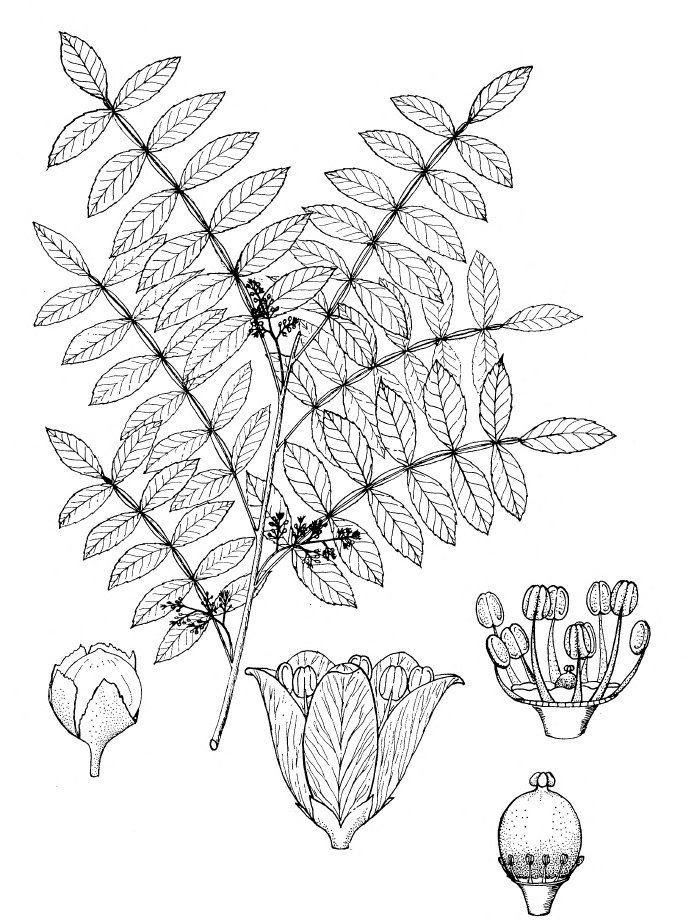Schinus terebinthifolia Raddi - syn.Schinus terebinthifolius Raddi; Schinus mucronulatus Mart.; Schinus antiarthritica Mart. ex Marchand - Anacardiaceae
Brazilian pepper tree, Christmas berry tree, Brasilianischer Pfefferbaum
Shrub or tree, native to South America (Brazil, Paraguay), naturalized (invasive) in Florida; leaves elliptic-oblong; flowers in axillary panicles, white; fruit a red drupe.
„Although it is not a true pepper (Piper), its dried drupes are often sold as pink peppercorns, as are the fruits from the related species Schinus molle (Peruvian peppertree). The seeds can be used as a spice, adding a pepper-like taste to food. They are usually sold in a dry state and have a bright pink color. They are less often sold pickled in brine, where they have a dull, almost green hue.“
http://en.wikipedia.org/wiki/Schinus_terebinthifolius
The major constituents in the essential oils extracted from the fruits collected in Dourados, Brazil were: α-pinene (22%), sabinene (15%), Z-salvene (10%), β-pinene (10%), α-funebrene (8%) and limonene (5%).
[Composição química e avaliação da atividade antitumoral do óleo essencial de Schinus terebinthifolius Raddi (Anacardiaceae)., Roveda, L.M., Formagio, A.S.N., da Siva Baldivia, D., Cauz, L.A., dos Santos, M.D.C.V., Cardoso, C.A.L., Foglio, M.A., In Anonymous Anais do X Simpósio Brasil-Japão, 2010. ]
http://japao.org.br/simposio2010/wp-content/uploads/2010/PA013.pdf
62 compounds were identified in the berry oil, the main were α-phellandrene (34%), β-phellandrene (10%), α-terpineol (5%), α-pinene (6%), β-pinene (3%) and p-cymene (7%). The sesquiterpene γ-cadinene (18%) was found to be a major part of the oil whereas only traces were detected in the essential oil of S. molle.
[Chemical composition and anticancer and antioxidant activities of Schinus molle L. and Schinus terebinthifolius Raddi berries essential oils., Bendaoud, H., Romdhane, M., Souchard, J.P., Cazaux, S., Bouajila, J., Journal of food science, Vol.75(6), 2010, C466-C472]
„S. terebinthifolius is largely found in the Brazilian coast, and is distributed from the northeast to the south part of the country. The biological applications of this plant have been known for many years, and its properties have been described since the first edition of the Brazilian Pharmacopoeia, published in 1926. It has been used in folk medicine as anti-inflammatory, antipyretic, analgesic and as a depurative agent. In addition, S. terebinthifolius has been used to treat sexually transmitted diseases, uterine inflammation, urinary tract infections, skin ulcers and gastroduodenal disorders (Cavalher-Machado, et al., 2008, Diniz, et al., 1997, Martinez, et al., 1996). Bacchi (1986) reports the use of aroeira species in the treatment of skin, mucous membrane injuries, ulcers and infections of the respiratory, digestive and genitourinary systems… In their studies, Jorge and Markmann (1996) demonstrated that the leaves and barks of S. terebinthifolius are equally rich in tannins and essential oils. Saponins, however, are restricted to the bark, where it also showed positive reactions for flavonoids, which generally have anti-inflammatory properties and might enhance the healing effect provided by the tannins.“
[Schinus terebinthifolius Raddi: chemical composition, biological properties and toxicity., Carvalho, M.G., Melo, A.G.N., Aragão, C.F.S., Raffin, F.N., Moura, T.F.A.L., Revista Brasileira de Plantas Medicinais, Vol.15(1), 2013, 158-169]
http://www.scielo.br/scielo.php?pid=S1516-05722013000100022&script=sci_arttext
„Schinus molle L. is just the most common and most used pink pepper. Yet, the Brazilian pink pepper, Schinus terebinthifolius Raddi is also used in perfumery, and actually is the pink pepper („Red Berries CO2 extract“) in the mega success 'Pleasures' (Estée Lauder, 1995) by Annie Buzantian and Alberto Morillas. The quality of Schinus terebinthifolius Raddi used in 'Pleasures' is actually harvested in Reunion and Mauritius islands, which is said to be the best. Besides this 'Bourbón pink pepper' quality, and the Bazilian one, S. terebinthifolius is also grown in Madagascar, Florida, and South Africa. In tropical regions, the S. terebinthifolius tree can reach 8-10 m in high, but on Reaunion and Mauritius it rarely exceeds 5 m, and thus is more like a bushy skrub. The fresh but at the same time warm-spicy woody-peppery odor of S. terebinthifolius is finer and less terpenic than that of S. molle, but otherwise they are similar and can be used interchangably if intended as a nuanceur only, and not a main note as in 'Pleasures'.“
Scent and Chemistry facebook 20151011
The essential oil (EO), hexane extract (HE), and dichloromethane extract (DE) of the fruits showed different profiles. Main components were (EO/HE/DE, %): α-pinene (23.4, 1.1, 9.4), β-pinene (1.0, 0.0, 3.6), α-terpinene (20.3, 0.0, 4.9), 1,8-cineole (8.2, 3.7, 14.0), β-phellandrene (10.1, 1.7, 24.7), caryophyllene (2.4, 11.9, 3.6), germacrene D (1.7, 13.6, 4.7), δ-cadinene (0.9, 1.4, 1.2).
[Oliveira, Mariana S. de, et al. „Chemical composition and antifungal and anticancer activities of extracts and essential oils of Schinus terebinthifolius Raddi fruit.“ (2018)] https://www.arca.fiocruz.br/bitstream/icict/27868/2/mariana_de_oliveira_et_all.pdf

Annals of the Missouri Botanical Garden, vol.54, p.371, t.7 (1967)
http://www.tropicos.org/Image/100230592
